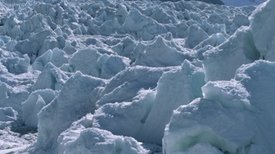Researchers try to figure out why every 20 years a Pakistan glacier moves roughly 1,500 times faster.
研究者尝试找出巴基斯坦冰川每隔20年移动速度快1500多倍的原因。
撰文\播音:史蒂夫•米尔斯基(Steve Mirsky)
翻译:陈美娟
审校:杨枭
Hi, I’m Scientific American podcast editor Steve Mirsky. And here’s a short piece from the April issue of the magazine, in the section we call Advances: Dispatches from the Frontiers of Science, Technology and Medicine:
Glacial Sprint by Katherine Kornei
大家好,我是“科学美国人”的播客编辑史蒂夫·米尔斯基。以下是一篇在4月刊登在“科学新进展”栏目(收录关于科学、技术、医药方面的最新发现)上的文章片段:《冰川的冲刺》——凯瑟琳·科涅(Katherine Kornei)。
Most glaciers creep along at a pace that is, well, glacial. But one in northern Pakistan breaks into a gallop with astounding speed and regularity: Khurdopin glacier “surges” every two decades, moving roughly 1,500 times its normal pace. This sends ice tumbling into a nearby river, damming it to create a temporary lake that can suddenly inundate nearby villages. Now scientists in Europe have used new high-resolution satellite data to study Khurdopin before and during its most recent surge in 2017, revealing how the event developed on a near daily basis, in unprecedented detail. The observations are critical to monitoring the glacier's hazards and could help to predict when flooding might occur next.
大多数冰川以一种冰川特有的姿态缓慢挪动。但巴基斯坦北部的一座冰川却以令人震惊的速度和规律性飞奔而行:名为Khurdopin的冰川每隔20年“激增”一次,将原先速度提升大概1500倍左右。这样的变化让冰块滚入附近的河流里,以此构成的临时蓄水湖能瞬间淹没附近的村庄。在激增现象发生的2017年前后,欧洲科学家们已经使用高分辨率卫星数据来研究,在几乎每日收集的数据基础下,对这个事件的成因进行了前所未有的详细解读。这些观测对于监控冰川的危害至关重要,同时能够预测下次洪水的发生。
About 1 percent of the world's glaciers exhibit such sudden and large bursts of speed. Jakob Steiner, a geoscientist at Utrecht University in the Netherlands, who led the study said: “It's not 100 percent clear why some glaciers surge and others don't.” Some scientists think water permeates a glacier's base and acts as a lubricant to promote sliding. Sediments between a glacier and the ground may also facilitate slippage.
世上1%的冰川会表现出突然加速的情况。来自荷兰乌特勒支大学,主导了这次研究的地球科学家雅各布·斯坦纳(Jakob Steiner)说:“我们并不是百分之百清楚为什么有些冰川有这种属性而有些不是。”有些科学家认为,水渗入了冰川基底,并作为一种润滑剂来促进冰川滑行。介于冰川和地面间的沉积物可能也起到帮助滑行的作用。
Steiner and his team analyzed new satellite images of Khurdopin that revealed features as small as three meters across. As snow accumulated on the high-elevation end of the 41-kilometer river of ice, the crushing pressure changed the structure of the water molecules, causing the ice to melt at lower temperatures and allowing the mass to suddenly shift. Khurdopin surged up to 20 meters a day in May 2017, creating a lake that grew to 30 times its size before draining and washing away roads, bridges and farmland, the scientists reported the finding in January in the journal The Cryosphere.
斯坦纳与他的团队分析了关于Khurdopin的新的卫星图像,图像显示冰川只有3米的宽度。随着雪在41公里长的冰河高地势部位的积累,不断挤压着的压力改变了水分子的结构,导致冰以更低的温度融化,最终使冰川这个大块头瞬间切换速度。2017年5月,Khurdopin的速度冲到了每日20米,形成了一个在溢出并冲刷路面、大桥、农田前就扩容到原先30倍大小的湖。科学家们将这项研究结果刊登在一月号的《冰冻圈》杂志上。
Steiner and his colleagues plan to return to Pakistan this year to continue installing temperature and rain sensors around Khurdopin and training area residents to monitor the glacier and its transient lake.
斯坦纳与他的同事们计划今年返回巴基斯坦以继续安装针对Khurdopin的温度及雨水感受器,并训练该地区的居民去监控冰川及其形成的临时湖泊。

 京公网安备11010502039775号
京公网安备11010502039775号  京公网安备11010502039775号
京公网安备11010502039775号 
















